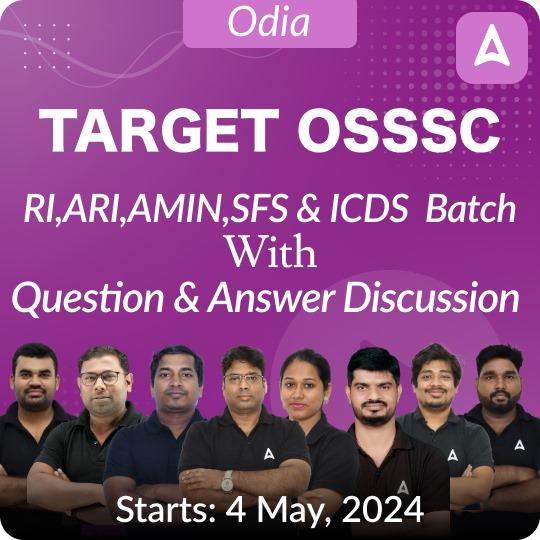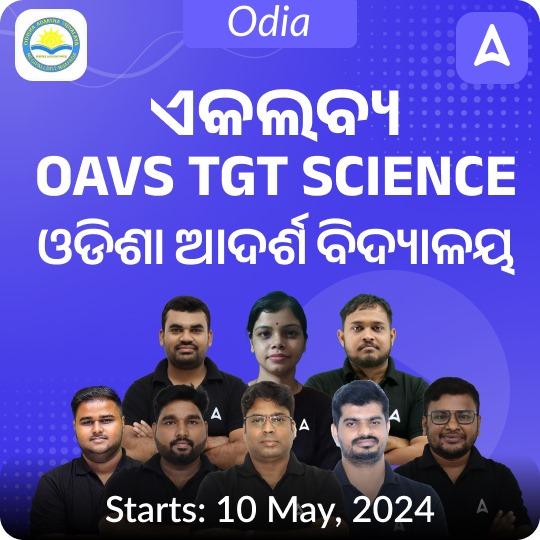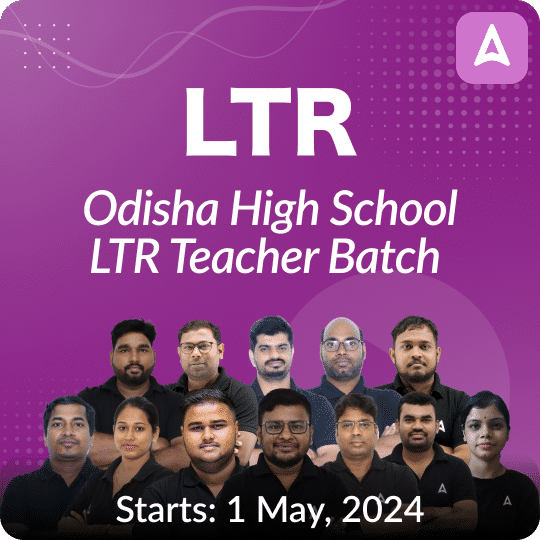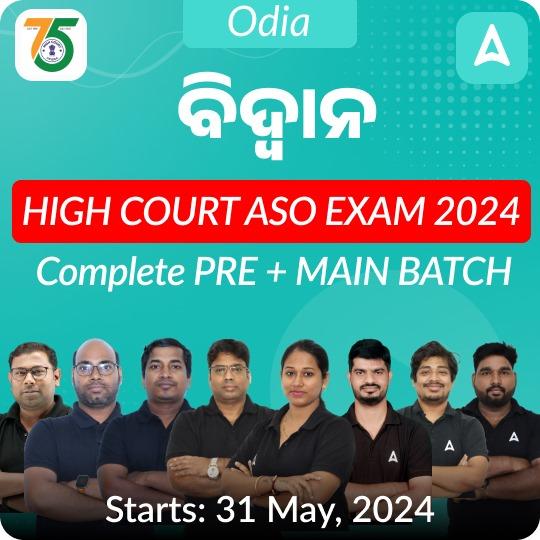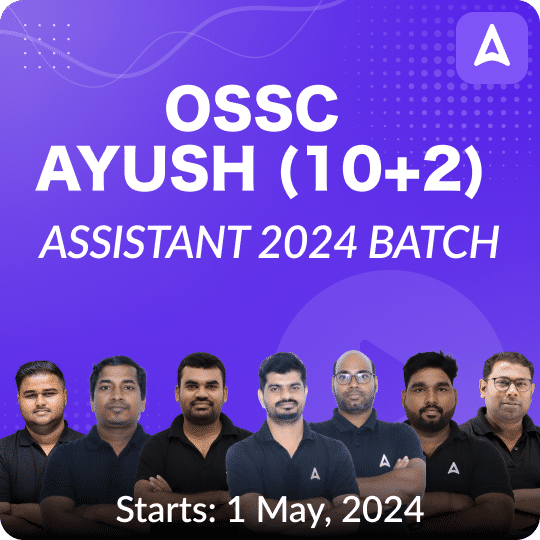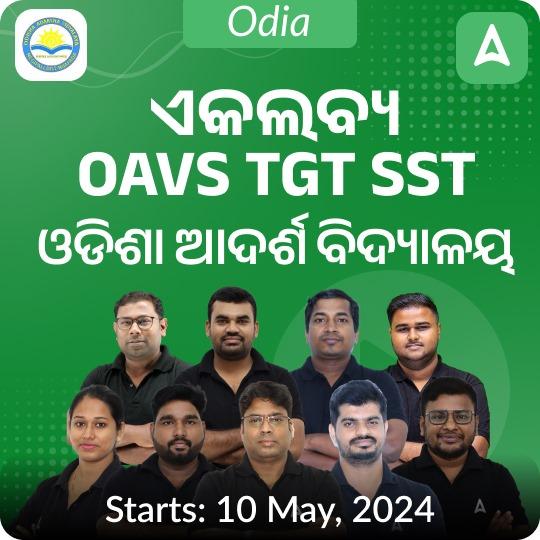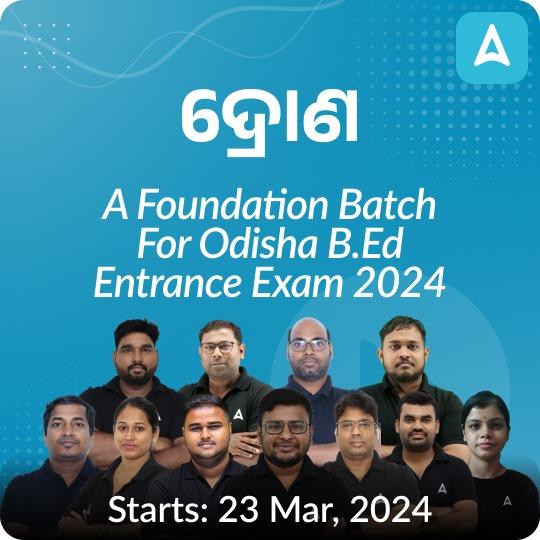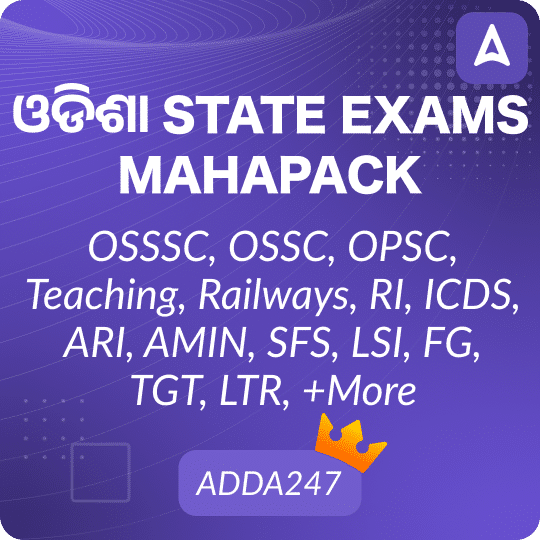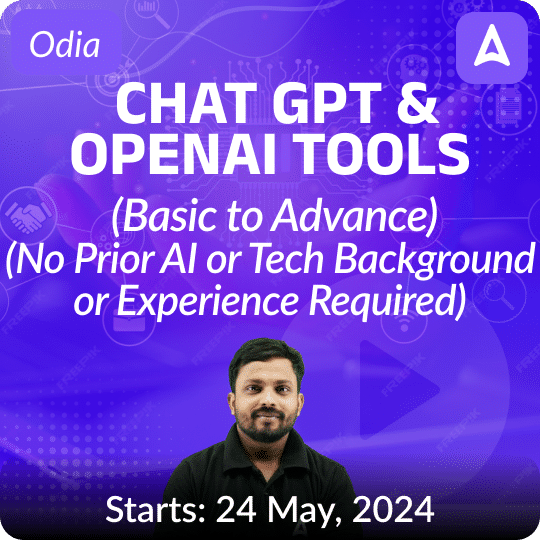Weekly Current affairs play a very important role in the competitive examinations and hence, aspirants have to give undivided attention to it while doing preparation for the government examinations. The CGLRE, OCS examinations comprise a section of “Current Affairs” to evaluate how much the aspirant is aware of the daily happenings taking place around the world. To complement your preparation, we are providing you with a compilation of Weekly Current affairs.
- Which region is Cyclone Dana expected to affect by October 24, 2024?
(a) Andhra Pradesh-Tamil Nadu
(b) Odisha-West Bengal
(c) Gujarat-Maharashtra
(d) Kerala-Karnataka
Ans: (b) Odisha-West Bengal
Explanation: Cyclone Dana, originating from the North Andaman Sea, is predicted to impact the Odisha-West Bengal coasts by October 24, 2024. - The name ‘Dana’ for Cyclone Dana was chosen by which country?
(a) India
(b) Bangladesh
(c) Pakistan
(d) Sri Lanka
Ans: (c) Pakistan
Explanation: The name “Dana” was selected from the list of names submitted by Pakistan for the North Indian Ocean Tropical Cyclones Naming System. - What does the Arabic word ‘dana’, which Cyclone Dana is named after, mean?
(a) Water
(b) Wind
(c) Grain or Corn
(d) Storm
Ans: (c) Grain or Corn
Explanation: The word “dana” is derived from Arabic, meaning “grain” or “corn.” - Which of the following is a key component of Odisha’s psychosocial care programme for disaster-prone districts?
(a) Financial aid distribution
(b) Counseling and therapy
(c) Food security programs
(d) Infrastructure development
Ans: (b) Counseling and therapy
Explanation: The psychosocial care programme focuses on providing mental health support, including counseling and therapy for disaster-affected individuals. - The ‘Ama Odisha Nabin Odisha’ scheme is set to be renamed to what?
(a) Swasth Odisha
(b) Bikasit Gaan Bikasit Odisha
(c) Shreshtha Odisha
(d) Unnati Odisha
Ans: (b) Bikasit Gaan Bikasit Odisha
Explanation: The Odisha government plans to rename the ‘Ama Odisha Nabin Odisha’ scheme to ‘Bikasit Gaan Bikasit Odisha’ to better reflect its focus on development. - Which of the following is NOT a focus area of the ‘Ama Odisha Nabin Odisha’ scheme?
(a) Sports infrastructure
(b) Banking and digital connectivity
(c) Disaster management training
(d) Internet facilities in villages
Ans: (c) Disaster management training
Explanation: The scheme focuses on infrastructure, digital connectivity, sports, and SHG training but not on disaster management training. - Odisha is set to integrate which state-run healthcare scheme with Ayushman Bharat?
(a) Odisha Jan Arogya Yojana
(b) Biju Swasthya Kalyan Yojana
(c) Gopabandhu Jan Arogya Yojana (G-JAY)
(d) Naveen Healthcare Yojana
Ans: (c) Gopabandhu Jan Arogya Yojana (G-JAY)
Explanation: Odisha plans to integrate the G-JAY with Ayushman Bharat to provide comprehensive health coverage. - What is a key feature of the Ayushman Bharat scheme?
(a) Free education for children
(b) Cashless treatment at empanelled hospitals
(c) Free housing for the poor
(d) Free food distribution during disasters
Ans: (b) Cashless treatment at empanelled hospitals
Explanation: Ayushman Bharat provides cashless healthcare services at empanelled hospitals across India. - From which tiger reserve will tigers be relocated to Similipal?
(a) Kanha Tiger Reserve
(b) Periyar Tiger Reserve
(c) Tadoba-Andhari Tiger Reserve
(d) Bandhavgarh Tiger Reserve
Ans: (c) Tadoba-Andhari Tiger Reserve
Explanation: Tigers from Tadoba-Andhari Tiger Reserve in Maharashtra are being relocated to Similipal to boost the big cat population. - How many tigers and cubs are currently estimated to be in Similipal Tiger Reserve?
(a) 10 tigers and 5 cubs
(b) 20 tigers and 8 cubs
(c) 27 tigers and 12 cubs
(d) 30 tigers and 15 cubs
Ans: (c) 27 tigers and 12 cubs
Explanation: Similipal Tiger Reserve is currently home to around 27 tigers and 12 cubs. - Which state’s tiger reserve will train a team from Similipal on translocation techniques?
(a) Rajasthan
(b) Gujarat
(c) Maharashtra
(d) Madhya Pradesh
Ans: (c) Maharashtra
Explanation: A team from Similipal is undergoing training in Maharashtra at Nawegaon-Nagzira Tiger Reserve. - What ecosystem is Tadoba-Andhari Tiger Reserve known for?
(a) Mangrove forests
(b) Tropical evergreen forests
(c) Tropical dry deciduous forests
(d) Alpine forests
Ans: (c) Tropical dry deciduous forests
Explanation: Tadoba-Andhari Tiger Reserve features a tropical dry deciduous forest ecosystem. - What type of natural disasters does the psychosocial care program in Odisha address?
(a) Droughts
(b) Cyclones, floods, and earthquakes
(c) Tornadoes
(d) Forest fires
Ans: (b) Cyclones, floods, and earthquakes
Explanation: The program provides mental health support to people affected by cyclones, floods, and earthquakes. - Which of the following is a key feature of the Gopabandhu Jan Arogya Yojana (G-JAY)?
(a) Provides free healthcare for all senior citizens
(b) Offers free housing to the underprivileged
(c) Offers health insurance coverage to a significant portion of Odisha’s population
(d) Funds the construction of new hospitals in rural areas
Ans: (c) Offers health insurance coverage to a significant portion of Odisha’s population
Explanation: G-JAY provides health insurance to a large section of Odisha’s population. - Which of the following sectors is NOT a focus of ‘Ama Odisha Nabin Odisha’?
(a) Education
(b) Healthcare
(c) Tourism development
(d) Infrastructure
Ans: (c) Tourism development
Explanation: While the scheme covers education, healthcare, and infrastructure, tourism development is not a primary focus. - Which year did the Odisha government launch the ‘Ama Odisha Nabin Odisha’ scheme?
(a) 2020
(b) 2021
(c) 2022
(d) 2023
Ans: (d) 2023
Explanation: The scheme was launched recently in 2023, with a focus on holistic state development. - Which natural disaster primarily affects the state of Odisha?
(a) Earthquakes
(b) Tsunamis
(c) Cyclones
(d) Drought
Ans: (c) Cyclones
Explanation: Odisha is frequently affected by cyclones, making disaster preparedness essential for the state. - In which national park is Tadoba-Andhari Tiger Reserve located?
(a) Satpura National Park
(b) Bandipur National Park
(c) Chandrapur National Park
(d) Kanha National Park
Ans: (c) Chandrapur National Park
Explanation: Tadoba-Andhari Tiger Reserve is located in Chandrapur district, Maharashtra. - What is the focus of the psychosocial care programme in Odisha?
(a) Building infrastructure in disaster-prone districts
(b) Offering mental health support to disaster-affected individuals
(c) Providing financial aid to disaster victims
(d) Improving agricultural output in flood-prone regions
Ans: (b) Offering mental health support to disaster-affected individuals
Explanation: The program aims to provide mental health support to individuals affected by natural disasters. - What type of mental health issues does the psychosocial care program in Odisha address?
(a) Schizophrenia
(b) Post-Traumatic Stress Disorder (PTSD)
(c) Bipolar disorder
(d) Dementia
Ans: (b) Post-Traumatic Stress Disorder (PTSD)
Explanation: The program specifically addresses anxiety, depression, and PTSD caused by natural calamities. - Which state has topped the capital outlay to GSDP ratio in 2024?
(a) Maharashtra
(b) Odisha
(c) Tamil Nadu
(d) Gujarat
Ans. (b) Odisha
Explanation: Odisha was found to have the highest capital outlay to GSDP ratio among major states, with a 4.4% ratio over the past decade. - What was the average capital outlay to GSDP ratio of Odisha during the last decade?
(a) 3.1%
(b) 4.4%
(c) 5.5%
(d) 6.0%
Ans. (b) 4.4%
Explanation: Odisha had an average capital outlay to GSDP ratio of 4.4%, which is higher than the 3.1% average for other major states. - Which state aims to transition from a low middle-income economy to a developed state by 2047?
(a) Andhra Pradesh
(b) West Bengal
(c) Odisha
(d) Karnataka
Ans. (c) Odisha
Explanation: Odisha has set an ambitious goal to transform from a low middle-income economy to a developed state by 2047. - Prabhat Samantaray, who passed away in 2024, was a former MP from which constituency?
(a) Bhubaneswar
(b) Puri
(c) Kendrapara
(d) Cuttack
Ans. (c) Kendrapara
Explanation: Prabhat Samantaray served as the Member of Parliament from Kendrapara for two terms, from 1998 to 2004. - In which year did Prabhat Samantaray pass away?
(a) 2022
(b) 2023
(c) 2024
(d) 2025
Ans. (c) 2024
Explanation: Prabhat Samantaray, the former Kendrapara MP, passed away on October 17, 2024. - The Odisha government reconstituted a task force to implement which policy in October 2024?
(a) Make in India
(b) NEP 2020
(c) Swachh Bharat Mission
(d) Skill India
Ans. (b) NEP 2020
Explanation: The task force was reconstituted to suggest measures for implementing the National Education Policy (NEP) 2020. - How many ex-officio members are part of the reconstituted task force for NEP-2020 in Odisha?
(a) 10
(b) 12
(c) 13
(d) 14
Ans. (c) 13
Explanation: The task force for NEP 2020 implementation in Odisha includes 13 ex-officio members. - Which organization is NOT part of the expert members in the NEP-2020 task force in Odisha?
(a) UNICEF
(b) Central Square Foundation
(c) PRATHAM
(d) World Health Organization
Ans. (d) World Health Organization
Explanation: The NEP 2020 task force includes members from UNICEF, Central Square Foundation (CSF), PRATHAM, and other educational foundations, but not the World Health Organization (WHO). - What is a key focus area of the NEP 2020?
(a) Boosting foreign investments
(b) Providing free meals in schools
(c) Ensuring holistic development of students
(d) Digital currency promotion
Ans. (c) Ensuring holistic development of students
Explanation: The NEP 2020 aims at the holistic development of students, focusing on cognitive, social, and emotional skills. - Habisyalis, mentioned in the context of Odisha news, undertake a religious fast in which temple?
(a) Konark Sun Temple
(b) Lingaraj Temple
(c) Jagannath Temple
(d) Rajarani Temple
Ans. (c) Jagannath Temple
Explanation: Habisyalis, devout women from Odisha, undertake the Kartika Brata, a religious fast, at the Jagannath Temple in Puri. - The Odisha government announced a helpline number for Habisyalis to address concerns during which festival?
(a) Rath Yatra
(b) Durga Puja
(c) Kartika Brata
(d) Makar Sankranti
Ans. (c) Kartika Brata
Explanation: The helpline for Habisyalis was introduced in Puri during the month-long religious fast called Kartika Brata. - What challenge do Habisyalis primarily face when visiting Puri during the Kartika Brata?
(a) Medical emergencies
(b) Lack of accommodations
(c) Transportation issues
(d) Food scarcity
Ans. (b) Lack of accommodations
Explanation: Habisyalis face challenges in finding proper accommodations when they visit Puri during the Kartika Brata. - Online registration for Habisyalis in Puri started on which date in 2024?
(a) October 1
(b) October 6
(c) October 10
(d) October 15
Ans. (b) October 6
Explanation: The Odisha government required online registration for Habisyalis’ accommodations starting from October 6, 2024. - The NEP 2020 emphasizes which of the following in the education sector?
(a) Vocational education
(b) Privatization of schools
(c) International education scholarships
(d) Teacher-centered learning
Ans. (a) Vocational education
Explanation: One of the key focuses of NEP 2020 is flexibility, offering vocational education and multiple pathways for learning. - Which term refers to the ratio of capital outlay to GSDP in a state’s economy?
(a) Capital surplus ratio
(b) Investment-GSDP ratio
(c) Capital outlay-GSDP ratio
(d) Debt-GSDP ratio
Ans. (c) Capital outlay-GSDP ratio
Explanation: The term “capital outlay-GSDP ratio” refers to the ratio of a state’s capital expenditure relative to its Gross State Domestic Product (GSDP). - Which foundation is involved as a special invitee in the NEP-2020 task force in Odisha?
(a) Bill & Melinda Gates Foundation
(b) AKSHARA Foundation
(c) Infosys Foundation
(d) Tata Trusts
Ans. (b) AKSHARA Foundation
Explanation: AKSHARA Foundation is among the expert members specially invited to the NEP-2020 task force. - Who is the current Chief Minister of Odisha as of October 2024?
(a) Naveen Patnaik
(b) Dharmendra Pradhan
(c) Biswa Bhusan Harichandan
(d) Baijayant Panda
Ans. (a) Naveen Patnaik
Explanation: Naveen Patnaik is the long-serving Chief Minister of Odisha as of 2024. - Which state has an average capital outlay to GSDP ratio lower than Odisha’s 4.4%?
(a) Kerala
(b) Punjab
(c) Bihar
(d) All of the above
Ans. (d) All of the above
Explanation: Odisha’s average capital outlay-GSDP ratio of 4.4% is higher than the national average of 3.1%, which includes states like Kerala, Punjab, and Bihar. - Habisyalis follow dietary and lifestyle restrictions for how long during the Kartika Brata?
(a) 7 days
(b) 15 days
(c) 30 days
(d) 45 days
Ans. (c) 30 days
Explanation: Habisyalis follow strict dietary and lifestyle restrictions for the entire month during the Kartika Brata. - Which organization is NOT a special invitee to the NEP-2020 task force in Odisha?
(a) PRATHAM
(b) Language Learning Foundation
(c) Central Square Foundation
(d) World Bank
Ans. (d) World Bank
Explanation: The World Bank is not part of the special invitees to the NEP-2020 task force in Odisha. Other educational foundations like PRATHAM and Language Learning Foundation are included. - Which financial year is Odisha’s supplementary budget for?
(a) 2022-23
(b) 2023-24
(c) 2024-25
(d) 2025-26
Ans: (c) 2024-25
Explanation: The Odisha government has started the process for the supplementary budget for the 2024-25 financial year to be presented during the winter session of the Assembly. - What was the total amount of the Odisha government’s annual budget presented in July 2024?
(a) ₹2.65 lakh crore
(b) ₹2.50 lakh crore
(c) ₹3.00 lakh crore
(d) ₹2.75 lakh crore
Ans: (a) ₹2.65 lakh crore
Explanation: In July 2024, the Odisha government presented an annual budget of ₹2.65 lakh crore. - Which Article of the Indian Constitution deals with supplementary grants?
(a) Article 113
(b) Article 115
(c) Article 112
(d) Article 116
Ans: (b) Article 115
Explanation: Article 115 allows for supplementary grants and votes on account to cover unforeseen expenses or immediate financial needs. - During which session will Odisha’s supplementary budget be placed in 2024?
(a) Budget Session
(b) Monsoon Session
(c) Winter Session
(d) Special Session Ans: (c) Winter Session
Explanation: Odisha’s supplementary budget will be placed during the Winter Session of the Assembly. - What year was the National Human Rights Commission (NHRC) of India established?
(a) 1991
(b) 1992
(c) 1993
(d) 1994
Ans: (c) 1993
Explanation: The NHRC was established in 1993 under the Protection of Human Rights Act, 1993. - What is the primary function of the NHRC?
(a) Promote international trade
(b) Protect and promote human rights
(c) Regulate law enforcement agencies
(d) Conduct national elections
Ans: (b) Protect and promote human rights
Explanation: The NHRC’s main function is to protect and promote human rights across India. - How many members does the NHRC have?
(a) 4
(b) 5
(c) 6
(d) 7
Ans: (c) 6
Explanation: The NHRC is a six-member body consisting of a Chairperson, two full-time members, and three ex-officio members. - In which city did the NHRC issue a notice related to the rape of an Odisha woman?
(a) Mumbai
(b) Kolkata
(c) Delhi
(d) Bengaluru
Ans: (c) Delhi
Explanation: The NHRC issued a notice to the Delhi government regarding the rape of an Odisha woman in the national capital. - Which natural site in Odisha is monitored by drones for the protection of birds?
(a) Bhitarkanika
(b) Chilika Lake
(c) Satkosia Gorge
(d) Simlipal National Park
Ans: (b) Chilika Lake
Explanation: Drones are being used to monitor Chilika Lake to protect its diverse avian population and prevent poaching. - What is Chilika Lake renowned for?
(a) It’s the largest freshwater lake in India
(b) It hosts numerous migratory birds
(c) It’s known for its coral reefs
(d) It’s located in central India
Ans: (b) It hosts numerous migratory birds
Explanation: Chilika Lake is famous for being a haven for migratory birds, especially during the winter months. - What is the name of the healthcare project launched by Utkal Alumina in Odisha?
(a) Project Arogya
(b) Project URMI
(c) Project Swasthya
(d) Project Sanjeevani
Ans: (b) Project URMI
Explanation: Utkal Alumina International Ltd launched Project URMI to improve healthcare in Rayagada and Kalahandi districts of Odisha. - How many people will benefit from Project URMI?
(a) 3,000
(b) 4,000
(c) 5,000
(d) 10,000
Ans: (c) 5,000
Explanation: Over 5,000 people across 40 villages will benefit from Project URMI. - In which districts is Project URMI being implemented?
(a) Khordha and Cuttack
(b) Rayagada and Kalahandi
(c) Puri and Bhubaneswar
(d) Ganjam and Balasore
Ans: (b) Rayagada and Kalahandi
Explanation: Project URMI is being implemented in the Rayagada and Kalahandi districts of Odisha. - What is one of the objectives of Project URMI?
(a) Promote tourism
(b) Achieve 100% institutional deliveries
(c) Improve road infrastructure
(d) Expand agricultural productivity
Ans: (b) Achieve 100% institutional deliveries
Explanation: One of the objectives of Project URMI is to achieve 100% institutional deliveries. - What kind of studies will be conducted as part of Project URMI?
(a) Economic studies
(b) Baseline, midline, and end-line health studies
(c) Environmental impact studies
(d) Educational research
Ans: (b) Baseline, midline, and end-line health studies
Explanation: These studies will be conducted to evaluate the health status of target groups under Project URMI. - When is the Winter Session of the Assembly typically held in India?
(a) February-March
(b) May-June
(c) July-August
(d) December-January
Ans: (d) December-January
Explanation: The Winter Session is generally held in December or January, which is when the Odisha supplementary budget will be presented. - What is the largest brackish water lagoon in Asia?
(a) Pulicat Lake
(b) Dal Lake
(c) Chilika Lake
(d) Loktak Lake
Ans: (c) Chilika Lake
Explanation: Chilika Lake in Odisha is the largest brackish water lagoon in Asia. - Which article of the Constitution discusses the annual financial statement?
(a) Article 112
(b) Article 113
(c) Article 115
(d) Article 116
Ans: (a) Article 112
Explanation: Article 112 outlines the annual financial statement, commonly known as the Budget. - What does NHRC stand for?
(a) National Human Resource Council
(b) National Human Rights Commission
(c) National Health and Research Council
(d) National Human Rehabilitation Committee
Ans: (b) National Human Rights Commission
Explanation: NHRC stands for the National Human Rights Commission, which is responsible for protecting and promoting human rights in India. - What is one of the NHRC’s key functions?
(a) Regulate private companies
(b) Promote constitutional amendments
(c) Investigate allegations of human rights violations
(d) Manage public infrastructure projects
Ans: (c) Investigate allegations of human rights violations
Explanation: One of the NHRC’s key functions is to investigate allegations of human rights violations by state agencies. - Which institution has been directed to remove encroachments and restore the Khandagiri caves to their original state?
(a) State Archaeology Department
(b) Ministry of Culture
(c) Archaeological Survey of India (ASI)
(d) Odisha State Government
Ans. (c) Archaeological Survey of India (ASI)
Explanation: The Orissa High Court has directed the ASI to take immediate steps to remove encroachments and restore the Khandagiri caves to their original state. - The Khandagiri Caves were primarily built during the reign of which ruler?
(a) Ashoka
(b) King Kharavela
(c) Chandragupta Maurya
(d) King Anangabhima Deva
Ans. (b) King Kharavela
Explanation: The Khandagiri Caves were constructed during the reign of King Kharavela in the 1st century BCE. - The Khandagiri Caves are located in which city of Odisha?
(a) Cuttack
(b) Puri
(c) Bhubaneswar
(d) Konark
Ans. (c) Bhubaneswar
Explanation: The Khandagiri Caves are located on the Khandagiri Hill in Bhubaneswar, Odisha. - Asha workers in Odisha are demanding a minimum monthly salary of how much?
(a) Rs 12,000
(b) Rs 15,000
(c) Rs 18,000
(d) Rs 20,000
Ans. (c) Rs 18,000
Explanation: Asha workers in Odisha are demanding a minimum monthly salary of Rs 18,000 as part of their regularization under the National Health Mission. - What pension amount are the Asha workers in Odisha demanding for retired staff?
(a) Rs 3,000
(b) Rs 5,000
(c) Rs 7,000
(d) Rs 10,000
Ans. (b) Rs 5,000
Explanation: Asha workers are demanding a pension of Rs 5,000 per month for retired staff. - The National Health Mission (NHM) was launched in which year?
(a) 2002
(b) 2005
(c) 2008
(d) 2010
Ans. (b) 2005
Explanation: The National Health Mission (NHM) is a flagship health program launched in 2005 to improve healthcare services in rural India. - Chilika Lake transforms into a vibrant bird sanctuary during which season?
(a) Summer
(b) Monsoon
(c) Winter
(d) Spring
Ans. (c) Winter
Explanation: Chilika Lake transforms into a vibrant bird sanctuary during the winter months as migratory birds arrive from various parts of the world. - 8. Which is India’s largest brackish water lagoon?
(a) Sambhar Lake
(b) Wular Lake
(c) Pulicat Lake
(d) Chilika Lake
Ans. (d) Chilika Lake
Explanation: Chilika Lake is the largest brackish water lagoon in India, located in Odisha. - 9. Migratory birds in Chilika Lake primarily come from which region?
(a) The Arctic Circle
(b) Northern Eurasia
(c) The Middle East
(d) The Amazon Basin
Ans. (b) Northern Eurasia
Explanation: Migratory birds that flock to Chilika Lake during the winter season come from regions beyond the Himalayas, primarily Northern Eurasia, Siberia, and other nearby areas. - 10. The Odisha government plans to establish which of the following to review and update its legal framework?
(a) Legal Advisory Council
(b) Judicial Reform Board
(c) Law Revision Commission
(d) Administrative Tribunal
Ans. (c) Law Revision Commission
Explanation: The Odisha government has announced plans to establish a Law Revision Commission to review and update outdated laws and legal provisions. - 11. The Odisha government aims to bring amendments to which Act, as part of its legal reforms?
(a) Forest Rights Act
(b) Right to Education Act
(c) Right to Information Act
(d) The Odisha Panchayati Raj Act
Ans. (c) Right to Information Act
Explanation: The Odisha government plans to bring amendments to the Right to Information Act, 2005, as part of its legal reforms. - 12. What is the key objective of establishing the Law Revision Commission in Odisha?
(a) Strengthening the judiciary
(b) Streamlining the legal system and improving access to justice
(c) Increasing penalties for criminal offenses
(d) Simplifying tax laws
Ans. (b) Streamlining the legal system and improving access to justice
Explanation: The Law Revision Commission is aimed at streamlining the legal system, enhancing access to justice, and promoting good governance in Odisha. - 13. Who are Asha workers primarily associated with?
(a) Ministry of Women and Child Development
(b) Ministry of Health and Family Welfare
(c) Ministry of Social Justice
(d) Ministry of Labour and Employment
Ans. (b) Ministry of Health and Family Welfare
Explanation: Asha workers are associated with the Ministry of Health and Family Welfare, working under the National Health Mission. - 14. The Udayagiri and Khandagiri Caves are examples of which type of architecture?
(a) Buddhist
(b) Jain
(c) Hindu
(d) Islamic
Ans. (b) Jain
Explanation: The Udayagiri and Khandagiri Caves are primarily examples of Jain rock-cut architecture. - 15. The arrival of which natural phenomenon enhances the scenic beauty of Chilika Lake in winter?
(a) Monsoon showers
(b) Migratory birds
(c) Flowering of lotus
(d) Algal blooms
Ans. (b) Migratory birds
Explanation: The scenic beauty of Chilika Lake is enhanced by the arrival of thousands of migratory birds in winter. - 16. Which districts in Odisha are witnessing large-scale protests by Asha workers for job regularization?
(a) Ganjam and Bhadrak
(b) Malkangiri and Koraput
(c) Mayurbhanj and Sundargarh
(d) Kendrapara and Balasore
Ans. (b) Malkangiri and Koraput
Explanation: Asha workers across Malkangiri and Koraput districts are demanding regularization of their jobs under the National Health Mission. - 17. Chilika Lake is situated along which coastline?
(a) Konkan Coast
(b) Coromandel Coast
(c) Malabar Coast
(d) Eastern Coastal Plains
Ans. (d) Eastern Coastal Plains
Explanation: Chilika Lake is situated along the Eastern Coastal Plains of India, near the Bay of Bengal in Odisha. - 18. Asha workers are recognized as the first point of contact for healthcare in which areas?
(a) Urban areas
(b) Semi-urban areas
(c) Rural areas
(d) Coastal areas
Ans. (c) Rural areas
Explanation: Asha workers are often the first point of contact for healthcare services in rural areas, especially in remote and underserved regions. - 19. What is the primary purpose of the National Health Mission (NHM)?
(a) Providing specialized healthcare
(b) Urban healthcare improvement
(c) Improving rural healthcare
(d) Healthcare for the elderly
Ans. (c) Improving rural healthcare
Explanation: The National Health Mission (NHM) primarily focuses on improving healthcare in rural areas and ensuring access to health services for vulnerable populations. - 20. In which district of Odisha is Khandagiri Hill located?
(a) Ganjam
(b) Puri
(c) Khordha
(d) Mayurbhanj
Ans. (c) Khordha
Explanation: Khandagiri Hill, home to the famous Khandagiri Caves, is located in the Khordha district, within the city of Bhubaneswar. - What is the primary aim of the ‘Odia Lipi’ typing method developed by OVA?
(a) To promote the use of English in Odisha
(b) To make Odia language typing tech-friendly and error-free
(c) To replace other typing tools like Akruti and Shreelipi
(d) To translate Odia into other languages more effectively
Ans. (b) To make Odia language typing tech-friendly and error-free
Explanation: ‘Odia Lipi’ aims to address the challenges of typing in Odia, by making it easier, more tech-friendly, and reducing errors in the process. - 2. Which organization developed the ‘Odia Lipi’ typing tool?
(a) OVA (Odia Virtual Academy)
(b) Microsoft India
(c) Odisha State Government
(d) Indic Academy
Ans. (a) OVA (Odia Virtual Academy)
Explanation: The typing tool ‘Odia Lipi’ was developed by OVA to assist Odia speakers in typing efficiently in their language. - 3. Which of the following is NOT a current Odia typing tool?
(a) Akruti
(b) Shreelipi
(c) Kalinga
(d) Sanskriti
Ans. (d) Sanskriti
Explanation: Akruti and Shreelipi are existing Odia typing tools, while Kalinga is a font, but Sanskriti is not a tool or font related to Odia typing. - 4. In the Microsoft Indic language input tool, what is the only Odia font available?
(a) Akruti
(b) Shreelipi
(c) Odia Script
(d) Kalinga
Ans. (d) Kalinga
Explanation: The font ‘Kalinga’ is currently the only one available for Odia in Microsoft’s Indic language input tool. - 5. By what percentage has groundwater extraction in Odisha increased over the last decade?
(a) 10%
(b) 15%
(c) 18%
(d) 20%
Ans. (c) 18%
Explanation: Groundwater extraction in Odisha has increased by 18% in the last decade, according to the Draft GroundWater Resource Assessment of Odisha-2024. - 6. What was the groundwater extraction rate in Odisha in 2013?
(a) 48.23%
(b) 30%
(c) 18%
(d) 60%
Ans. (b) 30%
Explanation: The groundwater extraction rate in Odisha was 30% in 2013, showing a significant rise over the past decade. - 7. As of 2023, what percentage of Odisha’s groundwater has been extracted?
(a) 48.23%
(b) 50%
(c) 35%
(d) 70%
Ans. (a) 48.23%
Explanation: Odisha’s groundwater extraction rate stood at 48.23% in 2023, indicating an increase from previous years. - 8. How many blocks in Odisha have been classified as fully saline?
(a) 4
(b) 6
(c) 9
(d) 12
Ans. (b) 6
Explanation: Six blocks in Odisha have been identified as fully saline, making groundwater unsuitable for extraction in those areas. - 9. What is the current stage of groundwater extraction in Odisha?
(a) 50%
(b) 60%
(c) 46.33%
(d) 48.23%
Ans. (c) 46.33%
Explanation: The overall stage of groundwater extraction in Odisha is currently at 46.33%. - 10. What is the estimated annual groundwater recharge in Odisha for 2023-24?
(a) 10.5 bcm
(b) 12.0 bcm
(c) 17.46 bcm
(d) 20.1 bcm
Ans. (c) 17.46 bcm
Explanation: The annual groundwater recharge for Odisha in 2023-24 is estimated to be 17.46 billion cubic meters (bcm). - 11. Which sector contributes the most to groundwater extraction in Odisha?
(a) Industrial
(b) Domestic
(c) Irrigation
(d) Urban Development
Ans. (c) Irrigation
Explanation: Irrigation is the primary contributor to groundwater extraction in Odisha, accounting for 6.28 billion cubic meters. - 12. What percentage of Odisha’s blocks are in the safe zone regarding groundwater extraction?
(a) 90%
(b) 95%
(c) 85%
(d) 99%
Ans. (b) 95%
Explanation: 95% of Odisha’s blocks, or 299 out of 314, are in the safe zone with extraction levels below 70%. - 13. How many blocks in Odisha are classified as semi-critical regarding groundwater extraction?
(a) 5
(b) 9
(c) 15
(d) 12
Ans. (b) 9
Explanation: Nine blocks in Odisha are classified as semi-critical with groundwater extraction levels exceeding 70%. - 14. What is the annual groundwater extraction in Odisha in 2023?
(a) 7.39 bcm
(b) 5.46 bcm
(c) 9.50 bcm
(d) 10.2 bcm
Ans. (a) 7.39 bcm
Explanation: The annual groundwater extraction in Odisha in 2023 is estimated to be 7.39 billion cubic meters. - 15. Which of the following is a tool aimed at improving Odia typing?
(a) Google Input Tools
(b) Odia Lipi
(c) Gboard
(d) Unicode Converter
Ans. (b) Odia Lipi
Explanation: Odia Lipi is a new typing tool developed by OVA to improve typing efficiency and accuracy in the Odia language. - 16. What is the current extractable groundwater resource in Odisha?
(a) 17.35 bcm
(b) 15.94 bcm
(c) 7.39 bcm
(d) 9.20 bcm
Ans. (b) 15.94 bcm
Explanation: The current extractable groundwater resource in Odisha is 15.94 bcm, according to the draft report. - 17. What was the annual groundwater recharge in Odisha in 2023?
(a) 10 bcm
(b) 15 bcm
(c) 17.35 bcm
(d) 20 bcm
Ans. (c) 17.35 bcm
Explanation: The annual groundwater recharge in Odisha for 2023 was 17.35 billion cubic meters. - 18. Which assessment report provides a detailed overview of Odisha’s groundwater resources?
(a) Odisha Water Commission Report 2024
(b) GroundWater Resource Assessment of Odisha-2024
(c) Central Water Board Report
(d) National Groundwater Survey
Ans. (b) GroundWater Resource Assessment of Odisha-2024
Explanation: The GroundWater Resource Assessment of Odisha-2024 is the draft report that provides detailed insights into the state’s groundwater usage and resources. - 19. Which tool is used to translate Odia to English in Microsoft’s Indic language input?
(a) Kalinga
(b) Odia Lipi
(c) Akruti
(d) Shreelipi
Ans. (a) Kalinga
Explanation: Kalinga is the font used in Microsoft’s Indic language input tool for translating Odia to English. - 20. Which of the following statements about Odisha’s groundwater status is true?
(a) Groundwater extraction is below the national average
(b) All blocks are in the semi-critical zone
(c) There are six fully saline blocks
(d) Groundwater extraction has decreased by 18%
Ans. (c) There are six fully saline blocks
Explanation: Six blocks in Odisha have been classified as fully saline, as per the groundwater resource assessment report. - What was discussed in the meeting between the Odia Language, Literature, and Culture department and Google India?
(a) Establishing Odia as a national language
(b) Representation of Odia language and literature digitally in a precise manner
(c) Creating a new script for Odia
(d) Launching a new Odia literature course
Ans: (b) Representation of Odia language and literature digitally in a precise manner
Explanation: The meeting focused on presenting Odia language and literature in a precise and error-free manner on digital platforms with the help of Google India. - 2. Odia is part of which language family?
(a) Dravidian
(b) Indo-Aryan
(c) Sino-Tibetan
(d) Uralic
Ans: (b) Indo-Aryan
Explanation: Odia belongs to the Indo-Aryan language family, similar to languages like Hindi, Bengali, and Sanskrit. - 3. What script is Odia written in?
(a) Devanagari
(b) Bengali
(c) Odia
(d) Tamil
Ans: (c) Odia
Explanation: Odia has its own script, which resembles the Bengali script. - 4. Which of the following is NOT a category in the 5th National Water Awards?
(a) Best Village Panchayat
(b) Best Industry
(c) Best Railway Station
(d) Best Civil Society
Ans: (c) Best Railway Station
Explanation: The 5th National Water Awards did not include “Best Railway Station” among its categories. - 5. Which district in Odisha was recognized as the best in the East Zone for water conservation in 2023?
(a) Cuttack
(b) Balangir
(c) Sambalpur
(d) Puri
Ans: (b) Balangir
Explanation: Balangir district was awarded the Best District in the East Zone for its water conservation efforts. - 6. What award did Odisha win in the 5th National Water Awards?
(a) Best District
(b) Best State
(c) Best School
(d) Best Institution
Ans: (b) Best State
Explanation: Odisha won the award for Best State in the 5th National Water Awards. - 7. Who announced the 5th National Water Awards?
(a) Prime Minister Narendra Modi
(b) President Droupadi Murmu
(c) Union Minister of Jal Shakti CR Patil
(d) Chief Minister Naveen Patnaik
Ans: (c) Union Minister of Jal Shakti CR Patil
Explanation: The awards were announced by the Union Minister of Jal Shakti, CR Patil. - 8. What is one of the key railway projects that President Murmu will inaugurate during her visit to Mayurbhanj?
(a) Balasore-Bhubaneswar project
(b) Bangiriposi-Gorumahisani project
(c) Sambalpur-Rourkela project
(d) Cuttack-Puri project Ans: (b) Bangiriposi-Gorumahisani project
Explanation: President Murmu will lay the foundation for the Bangiriposi-Gorumahisani railway project during her visit. - 9. Which district will President Murmu visit on October 23, 2024, to inaugurate multiple projects?
(a) Sundargarh
(b) Mayurbhanj
(c) Kendrapara
(d) Angul
Ans: (b) Mayurbhanj
Explanation: President Murmu is scheduled to visit Mayurbhanj on October 23, 2024. - 10. What will AI-based tools analyze to assess the quality of agricultural produce in Odisha?
(a) Nutritional content
(b) Water usage
(c) Moisture content, grain size, and color
(d) Market demand
Ans: (c) Moisture content, grain size, and color
Explanation: AI-based tools will use computer vision and machine learning to assess the quality of agricultural produce based on factors like moisture content, grain size, and color. - 11. What is the highest support price announced by the Odisha government for paddy per quintal?
(a) Rs 2,500
(b) Rs 3,100
(c) Rs 2,800
(d) Rs 3,000
Ans: (b) Rs 3,100
Explanation: The Odisha government announced the highest support price of Rs 3,100 per quintal of paddy. - 12. What is the term ‘Katni Chhatni’ related to in Odisha?
(a) Cultural practice
(b) Agricultural grain quality assessment
(c) Water management technique
(d) Traditional festival
Ans: (b) Agricultural grain quality assessment
Explanation: ‘Katni Chhatni’ refers to price reduction based on grain quality assessment in agriculture. - 13. Which technology is being used to prevent farmers from being harassed due to grain quality assessment issues?
(a) Blockchain
(b) Artificial Intelligence (AI)
(c) Internet of Things (IoT)
(d) Drones
Ans: (b) Artificial Intelligence (AI)
Explanation: AI tools will be employed to ensure accurate and fair assessment of grain quality in Odisha. - 14. Which classical language status was Odia recently granted along with four other languages?
(a) Hindi
(b) Sanskrit
(c) Tamil
(d) None of the above
Ans: (d) None of the above
Explanation: Odia, along with four other languages, was recently recognized as a classical language by the government. - 15. Which of the following is NOT a railway project that President Murmu will inaugurate?
(a) Budhamara-Chakulia
(b) Bangiriposi-Gorumahisani
(c) Balasore-Kolkata
(d) Badampahar-Keonjhar
Ans: (c) Balasore-Kolkata
Explanation: The Balasore-Kolkata project is not included in the three railway projects to be inaugurated by President Murmu. - 16. Where will President Murmu unveil a statue of Lord Ganesh during her visit?
(a) Bhubaneswar
(b) Punyeshwar Mahadev temple in Rairangpur
(c) Cuttack
(d) Puri
Ans: (b) Punyeshwar Mahadev temple in Rairangpur
Explanation: President Murmu will unveil the statue of Lord Ganesh at the Punyeshwar Mahadev temple in Rairangpur. - 17. What is the name of the airport foundation that President Murmu will lay during her visit?
(a) Bhubaneswar Airport
(b) Dandaboss Airport
(c) Cuttack Airport
(d) Rourkela Airport
Ans: (b) Dandaboss Airport
Explanation: President Murmu will lay the foundation for the Dandaboss Airport during her visit to Mayurbhanj. - 18. What is the focus of the Tribal Research Centre that President Murmu will lay the foundation for?
(a) Tribal history documentation
(b) Tribal healthcare
(c) Tribal education
(d) All of the above
Ans: (d) All of the above
Explanation: The Tribal Research Centre will focus on various aspects of tribal life, including history, healthcare, and education. - 19. What technological tools will be used to implement ‘Katni Chhatni’ in Odisha?
(a) Blockchain technology
(b) Artificial Intelligence and Machine Learning
(c) Satellite imaging
(d) Manual inspection
Ans: (b) Artificial Intelligence and Machine Learning
Explanation: AI and machine learning tools will be used for transparent and objective quality assessments of grains under ‘Katni Chhatni’. - 20. Which district’s sub-divisional hospital will see the foundation of a new building laid by President Murmu?
(a) Bhadrak
(b) Cuttack
(c) Rairangpur
(d) Puri
Ans: (c) Rairangpur
Explanation: President Murmu will lay the foundation for a new building at the sub-divisional hospital in Rairangpur. - The Union Ministry of Earth Sciences approved the installation of an X-band radar in Kerala’s Wayanad district. What is the primary application of X-band radar?
(a) Measuring air pollution levels
(b) Monitoring particle movements for landslide warnings
(c) Detecting electromagnetic radiation in the infrared spectrum
(d) Improving telecommunications in remote areas
Ans: (b) Monitoring particle movements for landslide warnings
Explanation: X-band radar emits radiation in the 8-12 GHz range, with high-resolution imaging that helps in monitoring particle movements. This technology is essential for early warning systems in regions prone to landslides. - 2. The X-band radar operates in which frequency range of the electromagnetic spectrum?
(a) 2-4 GHz
(b) 8-12 GHz
(c) 18-24 GHz
(d) 1-3 GHz
Ans: (b) 8-12 GHz
Explanation: X-band radar operates in the 8-12 GHz frequency range, corresponding to wavelengths of 2-4 cm. This allows for detailed detection, particularly in cloud and precipitation monitoring. - 3. Which dynasty is associated with the construction of the Kalleshwar Temple during its rule in the 10th century?
(a) Rashtrakuta Dynasty
(b) Gupta Dynasty
(c) Maratha Empire
(d) Vijayanagara Empire
Ans: (a) Rashtrakuta Dynasty
Explanation: The Kalleshwar Temple was constructed during the rule of the Rashtrakuta Dynasty in the mid-10th century and later saw developments under the Western Chalukya Empire. - 4. What is the architectural style of the Shikara at the Kalleshwar Temple?
(a) Mughal style
(b) Chola style
(c) Pallava style
(d) Gupta style
Ans: (b) Chola style
Explanation: The Shikara of the Kalleshwar Temple features the early Cholan architectural style, known for its pyramid-like structure and intricate carvings. - 5. What is the key objective of the MAHA-EV Mission launched by the Anusandhan National Research Foundation (ANRF)?
(a) Increase the import of electric vehicles
(b) Promote multi-institutional collaboration in space technology
(c) Position India as a global leader in electric vehicle (EV) technology
(d) Focus on the development of fossil fuel-based energy
Ans: (c) Position India as a global leader in electric vehicle (EV) technology
Explanation: The MAHA-EV Mission aims to promote domestic innovation, reduce dependency on imports, and position India as a global leader in electric vehicle technologies. - 6. Which of the following is NOT a key technological vertical under the MAHA-EV Mission?
(a) Power Electronics, Machines, and Drives (PEMD)
(b) Fossil Fuel Research
(c) Tropical EV Batteries and Battery Cells
(d) Electric Vehicle Charging Infrastructure
Ans: (b) Fossil Fuel Research
Explanation: The MAHA-EV Mission focuses on advancements in electric vehicle technologies, including batteries, power electronics, and charging infrastructure. Fossil fuel research is not part of this mission. - 7. According to the ‘EnviStats India-2024’ report, which tiger reserve ranks first for its leopard population?
(a) Jim Corbett Tiger Reserve
(b) Sundarbans Tiger Reserve
(c) Nagarjuna Sagar-Srisailam Tiger Reserve (NSTR)
(d) Bandipur Tiger Reserve
Ans: (c) Nagarjuna Sagar-Srisailam Tiger Reserve (NSTR)
Explanation: The NSTR ranks first in India for its leopard population, with an estimated 360 leopards, as per the ‘EnviStats India-2024’ report. - In which geographical location is the Nagarjuna Sagar-Srisailam Tiger Reserve situated?
(a) Eastern Ghats
(b) Western Ghats
(c) Shivalik Hills
(d) Satpura Range
Ans: (a) Eastern Ghats
Explanation: The Nagarjuna Sagar-Srisailam Tiger Reserve is located in the Nallamala hill ranges, an offshoot of the Eastern Ghats, and is the largest tiger reserve in India. - What is a major environmental benefit of biopolymers compared to synthetic polymers?
(a) They are cheaper to produce.
(b) They release more carbon emissions when burned.
(c) They are biodegradable and reduce pollution.
(d) They are non-biodegradable but stronger than synthetic polymers.
Ans: (c) They are biodegradable and reduce pollution.
Explanation: Biopolymers are biodegradable, decomposing easily by bacteria, which makes them environmentally friendly compared to synthetic polymers that contribute to pollution when incinerated. - Which city recently inaugurated India’s first Demonstration Facility for Biopolymers?
(a) Bengaluru
(b) Pune
(c) Chennai
(d) Hyderabad
Ans: (b) Pune
Explanation: India’s first Demonstration Facility for Biopolymers was inaugurated in Pune, focusing on sustainable materials that reduce carbon emissions and pollution. - When was the Hand-in-Hand Initiative launched by the Food and Agricultural Organization (FAO)? (a) 2018
(b) 2019
(c) 2020
(d) 2021
Ans: (b) 2019
Explanation: The Hand-in-Hand Initiative was launched in 2019 by the FAO with objectives such as eradicating poverty, ending hunger, and reducing inequalities. - Which Sustainable Development Goals (SDGs) are targeted by the Hand-in-Hand Initiative? (a) SDG 1, SDG 3, and SDG 5
(b) SDG 2, SDG 4, and SDG 10
(c) SDG 1, SDG 2, and SDG 10
(d) SDG 1, SDG 6, and SDG 11
Ans: (c) SDG 1, SDG 2, and SDG 10
Explanation: The Hand-in-Hand Initiative aims to achieve SDG 1 (Eradicate poverty), SDG 2 (End hunger), and SDG 10 (Reduce inequalities). - Which type of territories does the Hand-in-Hand Initiative prioritize? (a) Highly developed countries
(b) Countries with limited national capacities and significant operational challenges
(c) Urban regions
(d) Economically stable countries
Ans: (b) Countries with limited national capacities and significant operational challenges
Explanation: The initiative focuses on areas with high poverty and hunger rates, limited national capacities, and significant operational challenges. - What is the primary goal of the SARTHI system? (a) Enhance refrigerated transportation efficiency
(b) Reduce air pollution
(c) Build agro-industries
(d) Develop high-yield seeds
Ans: (a) Enhance refrigerated transportation efficiency
Explanation: The SARTHI system integrates solar energy and advanced control technologies to enhance the efficiency of refrigerated transportation. - Which feature of the SARTHI system allows transporters to make informed decisions on routing produce? (a) Dual compartment design
(b) Solar-powered air handling unit
(c) IoT integration and real-time monitoring
(d) Temperature control
Ans: (c) IoT integration and real-time monitoring
Explanation: The system collects data on key metrics like temperature and humidity, allowing real-time monitoring and rerouting decisions. - In which Union Territory is the Karakoram Wildlife Sanctuary located? (a) Jammu & Kashmir
(b) Ladakh
(c) Himachal Pradesh
(d) Uttarakhand
Ans: (b) Ladakh
Explanation: The Karakoram Wildlife Sanctuary is situated in Ladakh, along the Line of Actual Control (LAC). - Which major rivers flow through the Karakoram Wildlife Sanctuary? (a) Indus and Zanskar
(b) Ganga and Yamuna
(c) Shyok and Nubra
(d) Jhelum and Chenab
Ans: (c) Shyok and Nubra
Explanation: The Shyok and Nubra rivers flow through the Karakoram Wildlife Sanctuary, contributing to its unique ecosystem. - What type of insurance does the Employees’ Deposit Linked Insurance (EDLI) Scheme provide? (a) Health insurance
(b) Life insurance
(c) Vehicle insurance
(d) Crop insurance
Ans: (b) Life insurance
Explanation: The EDLI scheme offers term life insurance coverage to members of the Employees’ Provident Fund Organisation. - What is the maximum insurance benefit provided under the EDLI Scheme? (a) ₹5 lakh
(b) ₹10 lakh
(c) ₹7 lakh
(d) ₹3 lakh
Ans: (c) ₹7 lakh
Explanation: The maximum benefit under the EDLI scheme is ₹7 lakh, payable to the nominee or legal heir upon the death of the EPF member. - Where is Gandhi Sagar Wildlife Sanctuary located? (a) Rajasthan
(b) Madhya Pradesh
(c) Gujarat
(d) Maharashtra
Ans: (b) Madhya Pradesh
Explanation: Gandhi Sagar Wildlife Sanctuary is located in northwestern Madhya Pradesh, bordering Rajasthan. - What is the main objective of reintroducing cheetahs in Gandhi Sagar Sanctuary? (a) Biodiversity conservation
(b) Promote tourism
(c) Increase agricultural output
(d) Build solar farms
Ans: (b) Promote tourism
Explanation: The reintroduction of cheetahs in Gandhi Sagar Sanctuary aims to boost tourism in the region. - Which river divides the Gandhi Sagar Wildlife Sanctuary? (a) Ganga
(b) Yamuna
(c) Chambal
(d) Narmada
Ans: (c) Chambal
Explanation: The River Chambal flows through Gandhi Sagar Wildlife Sanctuary, dividing it into two parts. - What type of landscape characterizes the Gandhi Sagar Wildlife Sanctuary? (a) Desert
(b) Hills and plateaus
(c) Coastal region
(d) Plains
Ans: (b) Hills and plateaus
Explanation: The sanctuary features a diverse landscape of hills, plateaus, and the catchment area of the Gandhi Sagar Dam. - Which wildlife species are commonly found in the Gandhi Sagar Wildlife Sanctuary? (a) Tigers and Elephants
(b) Chinkara, Nilgai, and Spotted Deer
(c) Polar Bears
(d) Giraffes and Zebras
Ans: (b) Chinkara, Nilgai, and Spotted Deer
Explanation: Gandhi Sagar Wildlife Sanctuary is home to herbivores like Chinkara, Nilgai, and Spotted Deer. - What is the principal tree species found in Gandhi Sagar Wildlife Sanctuary? (a) Sal and Teak
(b) Khair, Salai, Kardhai
(c) Bamboo
(d) Deodar and Fir
Ans: (b) Khair, Salai, Kardhai
Explanation: The sanctuary’s principal tree species include Khair, Salai, Kardhai, Dhawda, Tendu, and Palash. - Which technology is used in the SARTHI system to extend the shelf life of transported goods? (a) Artificial Intelligence
(b) IoT and real-time monitoring
(c) Blockchain
(d) Cloud Computing
Ans: (b) IoT and real-time monitoring
Explanation: The SARTHI system uses IoT sensors and real-time monitoring to reduce spoilage and extend the shelf life of transported produce. - Which of the following peaks is located within the Karakoram Wildlife Sanctuary? (a) Mount Everest
(b) Saltoro Kangri
(c) K2
(d) Kanchenjunga
Ans: (b) Saltoro Kangri
Explanation: Saltoro Kangri is one of the major peaks located within the Karakoram Wildlife Sanctuary. - What is the average temperature in the warmest month in higher elevations of the Karakoram Wildlife Sanctuary? (a) Below 0°C
(b) 10°C
(c) 15°C
(d) 20°C
Ans: (a) Below 0°C
Explanation: The average temperature in the warmest month at higher elevations of the Karakoram Wildlife Sanctuary is below 0°C. - Which system provides cloud-based data access for real-time quality assessments in the SARTHI system? (a) GPS tracking
(b) IoT-based monitoring
(c) AI-based analytics
(d) Blockchain
Ans: (b) IoT-based monitoring
Explanation: The SARTHI system uses IoT sensors that collect data on various metrics, which is then sent to the cloud for real-time quality assessment. - Which National Park lies north of the Karakoram Wildlife Sanctuary? (a) Jim Corbett National Park
(b) Hemis National Park
(c) Gir National Park
(d) Kaziranga National Park
Ans: (b) Hemis National Park
Explanation: Hemis National Park is located to the north of the Karakoram Wildlife Sanctuary.



